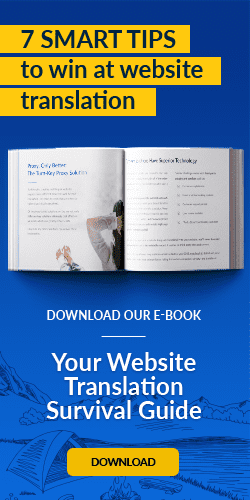There are a number of hidden costs when it comes to website localisation, and they can add up quickly. It's important to prepare for them so your project doesn't get derailed, turn off the very customers you're trying to attract, or potentially damage your brand and bottom line.
In Part One of this blog series, we looked at how the complexity of website localisation generates several types of costs that affect your budget and the business, including costs to your brand and workforce.
Now, let’s learn more about translation workflow costs, the expense of comprehensive translation and project coordination, as well as the technology-based solution that can eliminate them.
Translation Workflow Costs
The complex workflow required to translate website content completely and accurately is a major cost generator. A typical website translation workflow encompasses multiple time-consuming steps. For example, your internal team will have to:
- Identify content for translation
- Manually extract the content
- Send it to the translation agency
- Retrieve the translated content from the agency
- Review the translation for accuracy
- Inject the final content into the localised website
- Make sure the content displays properly
Many translation services have slow turnaround times for projects. The workflow is particularly cumbersome in the beginning of the project, since there's a steep learning curve for translators to learn your brand, style and preferences. Your website launch may take a year or more.
Speed is also critical for content updates once the site goes live. Delays can put the content of your localised site out of sync with your flagship site. That leads to confusion and frustration from your visitors as they stumble across untranslated text.
Delays of any kind can also negatively impact your business activities, since your in-country marketing team may be unable to promote new products, services and special offers in a timely way.
Costs of Comprehensive Translation
Creating a comprehensive, localised website with rich functionality requires translating a wide range of elements-many of which are not stored in your CMS. Beyond conventional text, you'll want to translate:
- Metadata and structured data
- Images with embedded text
- Videos
- Mobile applications
- Dynamically loaded third-party functionality such as customer review systems
- Dynamic PDFs such as customer account statements
- Code in JavaScript applications
- Other multimedia elements
Many traditional translation services lack the technology and expertise to detect this content in your website. This forces your marketing or IT team to locate, extract and deliver it to your vendor. In some cases, vendors can't handle the translation of these assets at all. You'll need to find experts who can.
Coordination Costs
A website translation project may succeed or fail based on the effectiveness of day-to-day workflow management. However, the issue-and costs-of coordination extend far beyond the collaboration between your team and a translation agency.
Your localised website is a tool to support and enable sales, marketing, business development, partnerships, investment and regulatory compliance.
If the initial launch and subsequent updates aren’t well coordinated, your global site won’t deliver the value your teams and customers depend on.
For instance, you’ll want to be sure translated content is posted in time to:
- Promote new products or services
- Feature new partners or investors
- Demonstrate compliance with new regulations
- Highlight a key customer’s success
- Generate demand for new marketing assets, such as a white paper or infographic
- Showcase a blog on a hot topic
The Answer: Technology-Based Translation Solutions
There's a way to elegantly sidestep these costly pitfalls. Advanced technology-based solutions address these costs by:
- Minimising labour-intensive processes
- Avoiding duplication
- Integrating with existing web management systems
- Automating workflows
One of the most powerful solutions for addressing hidden web translation costs is the turn-key proxy, which crawls your primary website to detect changes as they occur and automatically schedules the new content for translation, no matter what format it’s in.
Once translated content is received-and stored in the proxy solution's translation memory database for later use-it's used to populate the localised website and even assets in other channels, saving time, effort and precious steps that can slow down your website project.
To ensure the translated content fits your design templates, a turn-key proxy solution can supply "contextual integrity" interfaces to translators. These handy tools provide a live view of translations within the design of the site, enabling translators to see how content will actually appear and tweak translations in real-time to accommodate the site's page templates.
This radically reduces the time to vet and publish content. The costly alternative is going back and forth with web designers.
Conclusion
The complexity of traditional website translation approaches can mean unforeseen costs that impact your budget, your team and your business objectives.
The latest technology-based solutions can get these costs under control while delivering fast, high-quality, comprehensive translations that help your localised site meet the highest expectations of your global customers.
Last updated on July 10, 2018
